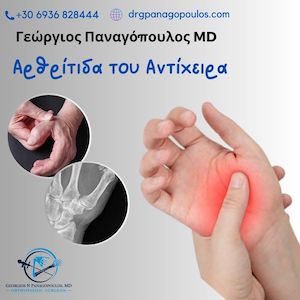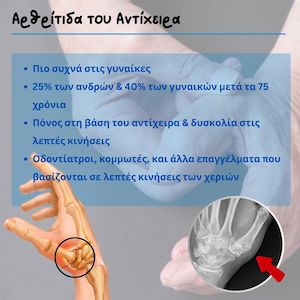Georgios Panagopoulos MD | Orthopaedic Surgeon

Table of contents
What is thumb arthritis?
Thumb arthritis or thumb CMC (carpometacarpal) joint arthritis is a very common condition that develops at the base of the thumb, between the trapezium and the thumb metacarpal bones. The smooth cartilage covering these bones undergoes wear and tear, gets thin and the bone ends rub against each other. Thumb arthritis affects more frequently women over 50 years of age and can run in the family.
Thumb arthritis may cause intense pain and swelling, and inability to perform fine motor tasks of the hand, such as turning a door handle, turning the keys to unlock a door, or opening a jar.



What causes thumb arthritis?
Risk factors for developing thumb CMC arthritis include:
- Female sex
- Age > 40
- Certain jobs or recreational activities that incur significant stress on the thumb
- Inflammatory arthropathies, such as rheumatoid arthritis
- Previous fractures around the area
Of note, there are also other forms of hand arthritis, such as osteoarthritis that typically affects the DIP joints, or rheumatoid arthritis of the fingers that primarily affects the PIP joints.
Thumb arthritis is common in professional that regularly perform fine tasks with their hands, such as dentists, or hairdressers.
What are the symptoms of thumb arthritis?
Symptoms of thumb CMC arthritis include:
- Pain at the base of the thumb, aggravated by use of the thumb
- Stiffness and restricted movements of the thumb
- Clumsiness - dropping objects
- Difficulty with tasks such as opening jars, turning keys, etc.
- Deformity, such as zig zag deformity, in severe cases.
Diagnosis
A thorough history and physical exam are necessary to raise suspicion of this diagnosis. DeQuervain’s and other hand conditions may present with similar symptoms. An x-ray of the hand is usually confirmatory.

Conservative treatment
Treatment of thumb CMC arthritis includes:
- Rest
- Activity modification - avoid activities that cause pain
- Splinting – a neoprene rubber splint is better than a rigid one
- Steroid injection – it can provide pain relief for a period of time. It may be repeated if needed. Dr Panagopoulos performs steroid injections in the office under ultrasound guidance.
Conservative treatment can provide relief for a long time. A cortisone injection is effective at 70% of cases, and can also have diagnostic value, if diagnosis is not completely clear.
Surgical Treatment
If conservative measures fail to provide long-term relief, the next step in treatment is surgery. There are a few surgical options available:
- Trapeziectomy & ligament reconstruction (LRTI) – this is the most common option. It is performed under general anaesthetic +/- regional block. The patient has a bulky dressing for a few days. This is a day case, and the patient can go home a few hours after the procedure.
- Arthroscopic debridement, suitable for early stages of disease.
- Fusion (arthrodesis) – this is another option. The joint is fused and can no longer move. This is typically an option reserved for the active professional that wants to go back to work as soon as possible, i.e., manual laborer, dentist, etc.
- Joint replacement (arthroplasty) – this is also an option, with long term results pending.
Dr Panagopoulos has extensive experience in hand and upper extremity surgery and will discuss all options with you during your visit in the office.
FAQs - Frequently Asked Questions
What is thumb arthritis?
Thumb arthritis or thumb CMC (carpometacarpal) joint arthritis is a very common condition that develops at the base of the thumb, between the trapezium and the thumb metacarpal bones.
Which professionals commonly get thumb arthritis?
Thumb arthritis is common in professional that regularly perform fine tasks with their hands, such as dentists, or hairdressers.
What are the symptoms?
– Thumb pain
– Thumb stiffness
– Dropping objects
– Inability to perform fine tasks like open a jar or turn the keys
What's the treatment?
– Rest
– Activity modification
– Splinting
– Cortisone injection
– Surgery (LRTI)
Find us
Book an appointment with us today
